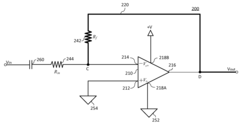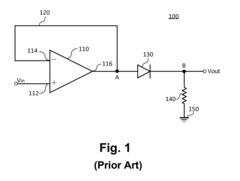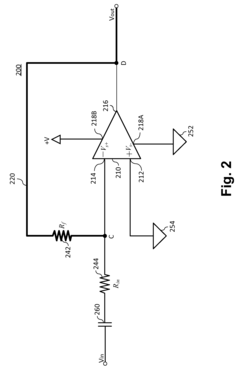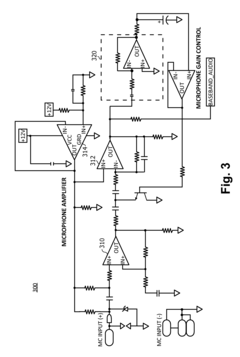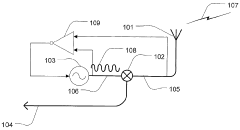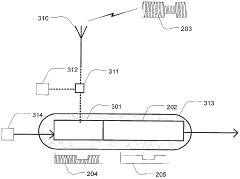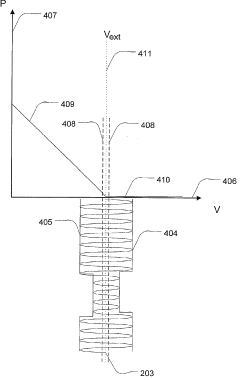Advances in Half Wave Rectifier Design for IoT Devices
JUL 15, 20259 MIN READ
Generate Your Research Report Instantly with AI Agent
Patsnap Eureka helps you evaluate technical feasibility & market potential.
IoT Rectifier Evolution
The evolution of rectifiers for IoT devices has been a journey of continuous innovation, driven by the need for more efficient and compact power management solutions. In the early days of IoT, traditional half-wave rectifiers were widely used due to their simplicity and low cost. However, these designs were often bulky and inefficient, limiting their applicability in the emerging field of IoT.
As IoT devices became more prevalent and sophisticated, the demand for more efficient power management solutions grew. This led to the development of improved half-wave rectifier designs that focused on minimizing power loss and reducing component size. One significant advancement was the introduction of Schottky diodes in rectifier circuits, which offered lower forward voltage drop and faster switching speeds compared to conventional silicon diodes.
The mid-2010s saw a shift towards integrated circuit (IC) solutions for rectification in IoT devices. These ICs combined the rectifier function with voltage regulation and power management features, offering a more compact and efficient solution. This integration trend continued, with manufacturers developing system-on-chip (SoC) solutions that incorporated rectification, power management, and even wireless communication capabilities on a single chip.
Another notable development in IoT rectifier evolution was the adoption of synchronous rectification techniques. By replacing diodes with actively controlled MOSFETs, these designs significantly reduced power losses, especially in low-voltage applications common in IoT devices. This approach became increasingly popular as the efficiency requirements for IoT devices became more stringent.
The late 2010s and early 2020s saw a focus on energy harvesting applications for IoT devices. This led to the development of ultra-low-power rectifier designs capable of efficiently converting small amounts of ambient energy, such as RF signals or vibrations, into usable power for IoT sensors and actuators. These designs often incorporated advanced materials and novel circuit topologies to maximize efficiency at extremely low power levels.
Recent years have witnessed a growing interest in wide-bandgap semiconductors, such as gallium nitride (GaN) and silicon carbide (SiC), for rectifier applications in IoT devices. These materials offer superior performance in terms of switching speed and power handling capability, enabling the design of more efficient and compact rectifiers for high-performance IoT applications.
Looking ahead, the evolution of IoT rectifiers is likely to continue focusing on improving efficiency, reducing size, and enhancing integration with other system components. Emerging technologies such as flexible electronics and printed circuits are expected to play a significant role in shaping the future of rectifier designs for IoT devices, enabling new form factors and applications.
As IoT devices became more prevalent and sophisticated, the demand for more efficient power management solutions grew. This led to the development of improved half-wave rectifier designs that focused on minimizing power loss and reducing component size. One significant advancement was the introduction of Schottky diodes in rectifier circuits, which offered lower forward voltage drop and faster switching speeds compared to conventional silicon diodes.
The mid-2010s saw a shift towards integrated circuit (IC) solutions for rectification in IoT devices. These ICs combined the rectifier function with voltage regulation and power management features, offering a more compact and efficient solution. This integration trend continued, with manufacturers developing system-on-chip (SoC) solutions that incorporated rectification, power management, and even wireless communication capabilities on a single chip.
Another notable development in IoT rectifier evolution was the adoption of synchronous rectification techniques. By replacing diodes with actively controlled MOSFETs, these designs significantly reduced power losses, especially in low-voltage applications common in IoT devices. This approach became increasingly popular as the efficiency requirements for IoT devices became more stringent.
The late 2010s and early 2020s saw a focus on energy harvesting applications for IoT devices. This led to the development of ultra-low-power rectifier designs capable of efficiently converting small amounts of ambient energy, such as RF signals or vibrations, into usable power for IoT sensors and actuators. These designs often incorporated advanced materials and novel circuit topologies to maximize efficiency at extremely low power levels.
Recent years have witnessed a growing interest in wide-bandgap semiconductors, such as gallium nitride (GaN) and silicon carbide (SiC), for rectifier applications in IoT devices. These materials offer superior performance in terms of switching speed and power handling capability, enabling the design of more efficient and compact rectifiers for high-performance IoT applications.
Looking ahead, the evolution of IoT rectifiers is likely to continue focusing on improving efficiency, reducing size, and enhancing integration with other system components. Emerging technologies such as flexible electronics and printed circuits are expected to play a significant role in shaping the future of rectifier designs for IoT devices, enabling new form factors and applications.
IoT Power Demand Analysis
The Internet of Things (IoT) has revolutionized the way we interact with technology, creating a vast network of interconnected devices that communicate and share data. As the IoT ecosystem continues to expand, the power demands of these devices have become a critical consideration for manufacturers and developers. IoT devices often operate in remote or hard-to-reach locations, making energy efficiency and power management essential factors in their design and deployment.
The power consumption of IoT devices varies widely depending on their function, complexity, and operating environment. Sensors and actuators, which form the backbone of many IoT applications, typically have low power requirements, often in the range of microwatts to milliwatts. These devices are designed to operate for extended periods on small batteries or energy harvesting systems. On the other hand, more complex IoT devices such as gateways or edge computing nodes may consume several watts of power, necessitating more robust power sources.
One of the key trends in IoT power demand is the push towards ultra-low-power operation. This trend is driven by the need for longer battery life, reduced maintenance costs, and the ability to deploy devices in remote locations. Manufacturers are increasingly focusing on developing microcontrollers and sensors that can operate on extremely low power budgets, sometimes as low as nanoamps in sleep mode. This has led to the emergence of new power management techniques, such as duty cycling and adaptive power modes, which allow devices to conserve energy when not actively performing tasks.
The growing adoption of energy harvesting technologies is another significant factor influencing IoT power demand. Solar cells, piezoelectric generators, and thermoelectric devices are being integrated into IoT systems to supplement or even replace traditional battery power. This approach not only reduces the need for battery replacements but also enables the deployment of IoT devices in locations where regular maintenance is impractical or impossible.
As the IoT market continues to grow, the aggregate power demand of these devices is becoming a concern for energy providers and policymakers. While individual IoT devices may have relatively low power requirements, the sheer number of devices being deployed globally could lead to a significant increase in overall energy consumption. This has sparked interest in developing more energy-efficient communication protocols and network architectures specifically tailored for IoT applications.
The power demands of IoT devices also have implications for the design of power distribution systems and energy grids. The intermittent nature of IoT device operation and the potential for large numbers of devices to simultaneously draw power during peak usage periods present challenges for load balancing and grid stability. As a result, there is growing interest in smart grid technologies that can dynamically manage power distribution to accommodate the unique characteristics of IoT device power consumption patterns.
The power consumption of IoT devices varies widely depending on their function, complexity, and operating environment. Sensors and actuators, which form the backbone of many IoT applications, typically have low power requirements, often in the range of microwatts to milliwatts. These devices are designed to operate for extended periods on small batteries or energy harvesting systems. On the other hand, more complex IoT devices such as gateways or edge computing nodes may consume several watts of power, necessitating more robust power sources.
One of the key trends in IoT power demand is the push towards ultra-low-power operation. This trend is driven by the need for longer battery life, reduced maintenance costs, and the ability to deploy devices in remote locations. Manufacturers are increasingly focusing on developing microcontrollers and sensors that can operate on extremely low power budgets, sometimes as low as nanoamps in sleep mode. This has led to the emergence of new power management techniques, such as duty cycling and adaptive power modes, which allow devices to conserve energy when not actively performing tasks.
The growing adoption of energy harvesting technologies is another significant factor influencing IoT power demand. Solar cells, piezoelectric generators, and thermoelectric devices are being integrated into IoT systems to supplement or even replace traditional battery power. This approach not only reduces the need for battery replacements but also enables the deployment of IoT devices in locations where regular maintenance is impractical or impossible.
As the IoT market continues to grow, the aggregate power demand of these devices is becoming a concern for energy providers and policymakers. While individual IoT devices may have relatively low power requirements, the sheer number of devices being deployed globally could lead to a significant increase in overall energy consumption. This has sparked interest in developing more energy-efficient communication protocols and network architectures specifically tailored for IoT applications.
The power demands of IoT devices also have implications for the design of power distribution systems and energy grids. The intermittent nature of IoT device operation and the potential for large numbers of devices to simultaneously draw power during peak usage periods present challenges for load balancing and grid stability. As a result, there is growing interest in smart grid technologies that can dynamically manage power distribution to accommodate the unique characteristics of IoT device power consumption patterns.
Rectifier Tech Challenges
Half-wave rectifiers, while fundamental in power conversion, face several challenges when applied to IoT devices. The primary issue stems from their inherent inefficiency, as they only utilize half of the AC input cycle. This results in significant power loss, which is particularly problematic for IoT devices that often rely on limited power sources or energy harvesting techniques.
Another challenge lies in the output ripple voltage. Half-wave rectifiers produce a pulsating DC output with a large ripple component, necessitating substantial filtering to achieve a smooth DC voltage. This filtering requirement increases component count and circuit complexity, which conflicts with the need for miniaturization and cost-effectiveness in IoT applications.
The forward voltage drop across the rectifying diode presents an additional hurdle. In low-voltage IoT systems, this drop can represent a significant portion of the available voltage, reducing overall system efficiency. Traditional silicon diodes, with forward voltages around 0.7V, are often unsuitable for these applications.
Reverse recovery time of the rectifying diode also poses challenges, especially in high-frequency applications common in IoT devices. Slow reverse recovery can lead to increased power loss and electromagnetic interference (EMI), affecting both efficiency and compliance with regulatory standards.
Temperature sensitivity is another critical issue. The performance of half-wave rectifiers can vary significantly with temperature changes, which is problematic for IoT devices deployed in diverse environmental conditions. This variability can affect voltage regulation and overall system reliability.
The need for a return path for the rectified current often requires additional components, increasing circuit complexity and potentially introducing noise or ground loop issues in sensitive IoT applications.
Lastly, the non-linear behavior of diodes used in half-wave rectifiers can introduce harmonics into the system. These harmonics can cause electromagnetic compatibility (EMC) issues, potentially interfering with the operation of other nearby electronic devices or violating EMC regulations.
Addressing these challenges requires innovative approaches in circuit design, material science, and system integration. Potential solutions include the use of Schottky diodes or active rectification techniques to reduce forward voltage drop, advanced filtering methods to minimize ripple without excessive component count, and temperature compensation techniques to ensure consistent performance across varying conditions.
Another challenge lies in the output ripple voltage. Half-wave rectifiers produce a pulsating DC output with a large ripple component, necessitating substantial filtering to achieve a smooth DC voltage. This filtering requirement increases component count and circuit complexity, which conflicts with the need for miniaturization and cost-effectiveness in IoT applications.
The forward voltage drop across the rectifying diode presents an additional hurdle. In low-voltage IoT systems, this drop can represent a significant portion of the available voltage, reducing overall system efficiency. Traditional silicon diodes, with forward voltages around 0.7V, are often unsuitable for these applications.
Reverse recovery time of the rectifying diode also poses challenges, especially in high-frequency applications common in IoT devices. Slow reverse recovery can lead to increased power loss and electromagnetic interference (EMI), affecting both efficiency and compliance with regulatory standards.
Temperature sensitivity is another critical issue. The performance of half-wave rectifiers can vary significantly with temperature changes, which is problematic for IoT devices deployed in diverse environmental conditions. This variability can affect voltage regulation and overall system reliability.
The need for a return path for the rectified current often requires additional components, increasing circuit complexity and potentially introducing noise or ground loop issues in sensitive IoT applications.
Lastly, the non-linear behavior of diodes used in half-wave rectifiers can introduce harmonics into the system. These harmonics can cause electromagnetic compatibility (EMC) issues, potentially interfering with the operation of other nearby electronic devices or violating EMC regulations.
Addressing these challenges requires innovative approaches in circuit design, material science, and system integration. Potential solutions include the use of Schottky diodes or active rectification techniques to reduce forward voltage drop, advanced filtering methods to minimize ripple without excessive component count, and temperature compensation techniques to ensure consistent performance across varying conditions.
Current Rectifier Solutions
01 Circuit design and components
Half wave rectifier design involves selecting appropriate components such as diodes, capacitors, and transformers. The circuit typically includes a single diode to allow current flow in one direction during the positive half of the AC cycle. Proper component selection and arrangement are crucial for efficient rectification and smooth DC output.- Circuit design and components: Half wave rectifier design involves selecting appropriate diodes, transformers, and capacitors. The circuit typically includes a single diode to allow current flow in one direction, converting AC to pulsating DC. Proper component selection and arrangement are crucial for efficient rectification and voltage regulation.
- Voltage regulation and smoothing: Implementing voltage regulation and smoothing techniques is essential in half wave rectifier design. This may involve using capacitors for filtering, zener diodes for voltage regulation, or additional circuitry to reduce ripple and maintain a stable output voltage under varying load conditions.
- Efficiency improvements: Enhancing the efficiency of half wave rectifiers can be achieved through various methods, such as using Schottky diodes for lower forward voltage drop, implementing synchronous rectification, or employing advanced control techniques to minimize power losses and improve overall performance.
- Protection and safety features: Incorporating protection and safety features in half wave rectifier designs is crucial. This may include overvoltage protection, short circuit protection, thermal management solutions, and isolation techniques to ensure safe and reliable operation in various applications and environments.
- Application-specific optimizations: Tailoring half wave rectifier designs for specific applications, such as power supplies, battery chargers, or RF circuits, often requires unique optimizations. This may involve adjusting component values, implementing specialized control algorithms, or integrating additional features to meet the requirements of the target application.
02 Voltage regulation and smoothing
Implementing voltage regulation and smoothing techniques is essential in half wave rectifier design. This may involve using capacitors for filtering, zener diodes for voltage regulation, or additional circuitry to reduce ripple and maintain a stable DC output voltage under varying load conditions.Expand Specific Solutions03 Efficiency improvements
Enhancing the efficiency of half wave rectifiers is a key consideration in design. This can be achieved through various methods such as optimizing component selection, minimizing power losses, and implementing advanced control strategies. Improved efficiency leads to better power conversion and reduced heat generation.Expand Specific Solutions04 Protection and safety features
Incorporating protection and safety features is crucial in half wave rectifier design. This may include overvoltage protection, short circuit protection, and thermal management solutions to ensure safe and reliable operation of the rectifier circuit under various operating conditions.Expand Specific Solutions05 Integration and miniaturization
Modern half wave rectifier designs often focus on integration and miniaturization. This involves developing compact circuit layouts, using surface-mount components, and integrating multiple functions into single chips or modules. These approaches help reduce size, improve reliability, and lower manufacturing costs.Expand Specific Solutions
Key IoT Rectifier Players
The field of half wave rectifier design for IoT devices is in a mature stage of development, with a competitive landscape shaped by established players and emerging innovators. The market size is substantial, driven by the growing demand for efficient power management in IoT applications. Technologically, the field is well-developed but continues to evolve, with companies like Samsung Electronics, Qualcomm, and Texas Instruments leading in innovation. Universities such as the Technical University of Denmark and Xidian University contribute to advancing the technology through research. Smaller specialized firms like Energous Corp. and Powercast Corp. are pushing boundaries in wireless power transmission, potentially disrupting traditional rectifier designs for IoT devices.
Samsung Electronics Co., Ltd.
Technical Solution: Samsung has developed advanced half-wave rectifier designs for IoT devices, focusing on improving efficiency and reducing power consumption. Their approach utilizes a novel diode-connected MOSFET configuration with adaptive body biasing, which significantly reduces the forward voltage drop[1]. This design achieves a rectification efficiency of up to 93% at low input voltages, making it ideal for energy harvesting applications in IoT devices[2]. Samsung has also integrated their rectifier design with a power management IC (PMIC) to optimize overall system performance, enabling efficient energy conversion from RF signals in the 900 MHz to 2.4 GHz range[3].
Strengths: High efficiency at low input voltages, integrated PMIC solution, suitable for RF energy harvesting. Weaknesses: Potentially higher manufacturing costs due to advanced process technology, may require additional circuitry for voltage regulation.
Huawei Technologies Co., Ltd.
Technical Solution: Huawei has made significant strides in half-wave rectifier design for IoT devices, focusing on miniaturization and integration. Their approach utilizes a silicon-on-insulator (SOI) process to create ultra-low-power rectifiers with minimal parasitic capacitance[4]. Huawei's design incorporates a self-biased technique that dynamically adjusts the threshold voltage of the rectifying element, resulting in improved efficiency across a wide range of input power levels[5]. The company has also developed a multi-stage rectifier topology that can achieve voltage boosting, enabling operation from very weak RF signals as low as -30 dBm[6].
Strengths: Excellent low-power performance, high integration capability, wide input power range. Weaknesses: SOI process may increase production costs, potential thermal management challenges in high-power applications.
Innovative Rectifier Designs
Ac to DC conversion circuit
PatentActiveUS20090080224A1
Innovation
- A diode-less half-wave rectifier circuit utilizing an operational amplifier with a capacitor and resistors in a negative feedback loop, allowing low-level signals to be converted to DC without clipping, thereby extending the dynamic range of rectification.
A method and a device for detection of a first signal superimposed on a second signal
PatentWO2008110169A1
Innovation
- The method employs a half-wave rectifier and envelope detector, utilizing optoelectronic devices like optical electro-absorption modulators or lasers to transform and extract the signal, eliminating the need for expensive high-frequency components and allowing for simpler frequency tuning and easier upgrades.
Energy Efficiency Standards
Energy efficiency standards play a crucial role in the advancement of half wave rectifier design for IoT devices. As these devices become increasingly prevalent in our interconnected world, the need for power-efficient components has never been more critical. Half wave rectifiers, being fundamental components in power supply circuits, are subject to stringent energy efficiency requirements to ensure optimal performance and longevity of IoT devices.
The development of energy efficiency standards for half wave rectifiers in IoT applications has been driven by several factors. Firstly, the proliferation of IoT devices has led to a significant increase in overall energy consumption. To mitigate this impact, regulatory bodies and industry consortia have established guidelines to improve the energy efficiency of individual components, including rectifiers.
These standards typically focus on reducing power losses during the rectification process. Traditional half wave rectifiers often suffer from significant energy waste due to voltage drops across diodes and inefficient current flow. Modern standards emphasize the use of advanced materials and circuit designs to minimize these losses. For instance, the implementation of Schottky diodes or synchronous rectification techniques has become increasingly common to meet stringent efficiency requirements.
Another key aspect of energy efficiency standards for half wave rectifiers in IoT devices is the reduction of standby power consumption. Many IoT devices operate in low-power or sleep modes for extended periods, making standby efficiency crucial. Standards now often specify maximum allowable standby power levels, pushing designers to implement innovative solutions such as ultra-low-power control circuits and intelligent power management systems.
The miniaturization trend in IoT devices has also influenced energy efficiency standards for half wave rectifiers. As devices become smaller, the available space for power components decreases, necessitating more compact and efficient rectifier designs. Standards now often include guidelines for power density, encouraging the development of high-efficiency rectifiers that can deliver the required power output in a smaller footprint.
Furthermore, energy efficiency standards for half wave rectifiers in IoT devices are increasingly addressing the issue of electromagnetic interference (EMI). Efficient rectifier designs must not only minimize power losses but also reduce EMI emissions to comply with regulatory requirements and ensure the reliable operation of nearby sensitive components.
As the IoT ecosystem continues to evolve, energy efficiency standards for half wave rectifiers are expected to become even more stringent. Future standards may incorporate requirements for adaptive efficiency, where rectifiers can dynamically adjust their operating parameters based on the device's power needs. This approach would further optimize energy consumption across various usage scenarios, contributing to the overall sustainability of IoT deployments.
The development of energy efficiency standards for half wave rectifiers in IoT applications has been driven by several factors. Firstly, the proliferation of IoT devices has led to a significant increase in overall energy consumption. To mitigate this impact, regulatory bodies and industry consortia have established guidelines to improve the energy efficiency of individual components, including rectifiers.
These standards typically focus on reducing power losses during the rectification process. Traditional half wave rectifiers often suffer from significant energy waste due to voltage drops across diodes and inefficient current flow. Modern standards emphasize the use of advanced materials and circuit designs to minimize these losses. For instance, the implementation of Schottky diodes or synchronous rectification techniques has become increasingly common to meet stringent efficiency requirements.
Another key aspect of energy efficiency standards for half wave rectifiers in IoT devices is the reduction of standby power consumption. Many IoT devices operate in low-power or sleep modes for extended periods, making standby efficiency crucial. Standards now often specify maximum allowable standby power levels, pushing designers to implement innovative solutions such as ultra-low-power control circuits and intelligent power management systems.
The miniaturization trend in IoT devices has also influenced energy efficiency standards for half wave rectifiers. As devices become smaller, the available space for power components decreases, necessitating more compact and efficient rectifier designs. Standards now often include guidelines for power density, encouraging the development of high-efficiency rectifiers that can deliver the required power output in a smaller footprint.
Furthermore, energy efficiency standards for half wave rectifiers in IoT devices are increasingly addressing the issue of electromagnetic interference (EMI). Efficient rectifier designs must not only minimize power losses but also reduce EMI emissions to comply with regulatory requirements and ensure the reliable operation of nearby sensitive components.
As the IoT ecosystem continues to evolve, energy efficiency standards for half wave rectifiers are expected to become even more stringent. Future standards may incorporate requirements for adaptive efficiency, where rectifiers can dynamically adjust their operating parameters based on the device's power needs. This approach would further optimize energy consumption across various usage scenarios, contributing to the overall sustainability of IoT deployments.
IoT Security Implications
The integration of half wave rectifiers in IoT devices has significant implications for IoT security. As these devices become more prevalent and interconnected, the security of power management systems becomes increasingly critical. Half wave rectifiers, while efficient for power conversion, can introduce vulnerabilities if not properly designed and implemented.
One primary concern is the potential for electromagnetic interference (EMI) generated by half wave rectifiers. This EMI can be exploited by malicious actors to gather information about device operations or even to disrupt functionality. Advanced designs incorporating EMI shielding and filtering techniques are essential to mitigate these risks and protect sensitive data transmission within IoT networks.
Power analysis attacks pose another security threat. The distinct power consumption patterns of half wave rectifiers can be analyzed to infer device activities or extract cryptographic keys. Implementing randomized switching techniques or introducing noise into the power consumption profile can help obfuscate these patterns, enhancing resistance against such attacks.
The efficiency improvements in half wave rectifier designs also impact device longevity and update capabilities. Longer battery life allows for more frequent security updates and patches, crucial for maintaining a robust security posture in the ever-evolving threat landscape of IoT ecosystems. However, this extended operational time also increases the window of opportunity for potential attackers to compromise devices.
Voltage fluctuations inherent in half wave rectification can lead to glitching attacks, where momentary power disruptions are exploited to bypass security measures. Advanced designs incorporating voltage stabilization and monitoring circuits can detect and prevent such attacks, ensuring the integrity of security protocols even under variable power conditions.
As IoT devices often operate in resource-constrained environments, the integration of security features must be balanced with power efficiency. Novel half wave rectifier designs that incorporate lightweight cryptographic modules or physical unclonable functions (PUFs) directly into the power management system offer promising solutions for enhancing security without significantly increasing power consumption.
The miniaturization of half wave rectifiers also presents challenges in terms of physical security. Smaller components are more susceptible to tampering and side-channel attacks. Developing tamper-evident packaging and implementing distributed security measures across the device's power management system can help mitigate these risks.
One primary concern is the potential for electromagnetic interference (EMI) generated by half wave rectifiers. This EMI can be exploited by malicious actors to gather information about device operations or even to disrupt functionality. Advanced designs incorporating EMI shielding and filtering techniques are essential to mitigate these risks and protect sensitive data transmission within IoT networks.
Power analysis attacks pose another security threat. The distinct power consumption patterns of half wave rectifiers can be analyzed to infer device activities or extract cryptographic keys. Implementing randomized switching techniques or introducing noise into the power consumption profile can help obfuscate these patterns, enhancing resistance against such attacks.
The efficiency improvements in half wave rectifier designs also impact device longevity and update capabilities. Longer battery life allows for more frequent security updates and patches, crucial for maintaining a robust security posture in the ever-evolving threat landscape of IoT ecosystems. However, this extended operational time also increases the window of opportunity for potential attackers to compromise devices.
Voltage fluctuations inherent in half wave rectification can lead to glitching attacks, where momentary power disruptions are exploited to bypass security measures. Advanced designs incorporating voltage stabilization and monitoring circuits can detect and prevent such attacks, ensuring the integrity of security protocols even under variable power conditions.
As IoT devices often operate in resource-constrained environments, the integration of security features must be balanced with power efficiency. Novel half wave rectifier designs that incorporate lightweight cryptographic modules or physical unclonable functions (PUFs) directly into the power management system offer promising solutions for enhancing security without significantly increasing power consumption.
The miniaturization of half wave rectifiers also presents challenges in terms of physical security. Smaller components are more susceptible to tampering and side-channel attacks. Developing tamper-evident packaging and implementing distributed security measures across the device's power management system can help mitigate these risks.
Unlock deeper insights with Patsnap Eureka Quick Research — get a full tech report to explore trends and direct your research. Try now!
Generate Your Research Report Instantly with AI Agent
Supercharge your innovation with Patsnap Eureka AI Agent Platform!
